Allis Chalmers 8000-series: Bad timing.
Jul. 27, 2022 • Interesting Iron
In my opinion, the Allis Chalmers 8000-series tractors were a good mid-range tractor – maybe some of their best. Certain models had their issues, that’s true, but overall they were good machines. That said, they ALL suffered from one fatal flaw…bad timing. We’ll get into that in a minute, but let’s get the auction details out of this sweet A-C 8050 selling in a few days!
Auction Date: August 1, 2022 – 9AM CDT (Online bidding is open right now.)
Auctioneer: Wrightz Auction Co. LLC
Format: Live Auction with online bidding – 9AM CDT start time
Location: Floyd, IA
Auction Catalog
Link to the 1984 Allis-Chalmers 8050
It was the best of times…
Allis-Chalmers seemed to hit its stride in the late 60s with the Hundred Series tractors. 190XTs sold like hotcakes, and when the 210 & 220 were added to the lineup as the big horses in 1970, they sold well too. Still, the line was getting a little long in the tooth, and dealers wanted a shiny new toy to sell so they could compete with Harvester’s 66-series and Deere’s Sound Gards.
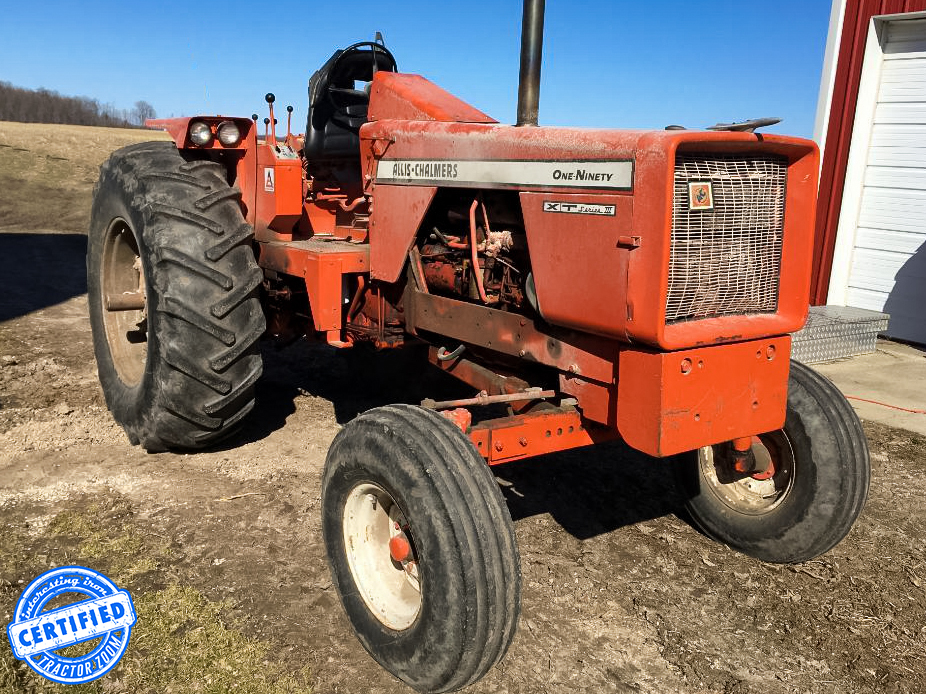
So, when the first of the all-new 7000-series tractors rolled out of West Allis for the 1973 model year, dealers jumped in with both feet and pushed pretty hard. The Acousta-Cab was a major development for Allis, as I believe it was their first true factory cab, and it was a pretty big selling point for those tractors.

Anyway, to make a long story short, the 7000-series tractors sold throughout the 70s and into the early 80s. Back home in Michigan, I know there’s at least one or two families in my neck of the woods who farmed pretty exclusively orange when I was growing up, and I’ll bet they’ve still got one or two of these sitting in the shed!
…but the worst of times were coming.
All right Interesting-Iron-Guy, we know all that. What’s with the doom and gloom? Let’s talk about 8000s.
Hang on; we’re getting there.
See, here’s the thing. The 8000-series and the worst of times kind of happened at the same time. If I’m being objective(ish) about this, these two stories need to be told together.
The Allis Chalmers 8000-series
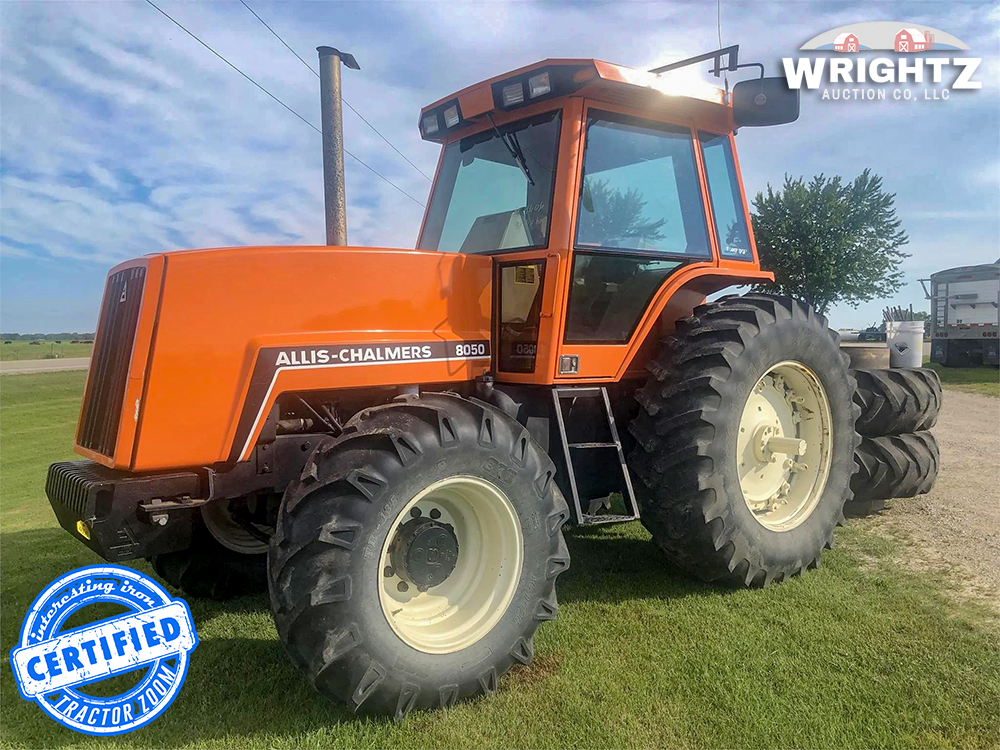
A-C’s top brass knew that the market was evolving pretty rapidly, and their competitors were continually freshening up designs and introducing new features to remain competitive. Allis hadn’t always done a lot of that. Not that they weren’t keeping up with Harvester and Deere, but they seemed to hang on to designs a little longer. Furthermore, farmers were starting to look for more comfort and efficiency in the field, as they were spending more time there than ever before.
So, when they debuted the 8000-series to their dealers in Reno back in late 1981, they really put the spotlight on two major selling points to address those issues – the cab, and a power front axle.
Comfort: The Cab
The Acousta Cab design was a double-edged sword, as far as I’m concerned (and this is just me talking). Yes, they were quiet. They tested quieter than a Sound Gard, in fact.
To me, they look awfully cramped. The Allis guys have all assured me that I’ll fit (I’m a big guy) and that it won’t feel like that scene in Tommy Boy where Chris Farley puts on David Spade’s suit jacket. Some day, I’m going to put their reassurances to the test. When I do, I’ll have somebody take video of me getting in and out. I might look like a contortionist getting in (or not), but either way, it’ll probably be entertaining TikTok content!
Fortunately, the 8000-series didn’t carry that cab over. Instead, farmers got a great big new box to sit in. It had big doors – 40″ wide at the belt-line – and yes, I said doors (plural). As much as John Deere fans love to talk about their cabs being outstanding, it is more convenient to be able to get in the tractor from either side.
Inside, the cab was quite roomy and spacious. A-C’s marketing people touted that it had 38% more room, and better visibility, too. Less blind spots are always nice.
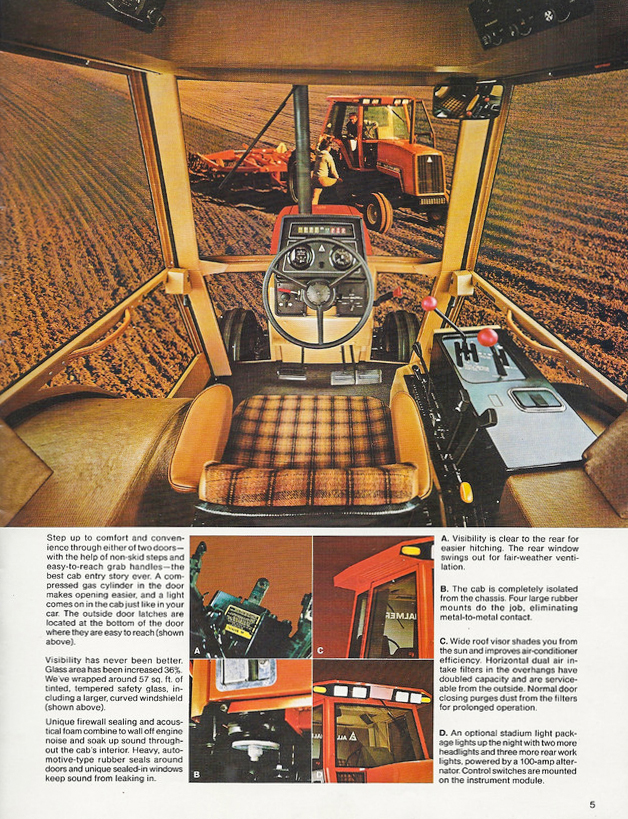
Sidebar: Ever wonder how they make cabs look so huge in photos like that? It’s not Photoshop wizardry. It was all in the camera setup. The photographer who took that picture used a super wide angle lens to make the cab look so wide and expansive. If you’ve got a new(ish) iPhone, you can do it too. Try using the 0.5 lens next time you take a picture. It’ll do the same thing. (I’m not an Android guy, but I’d imagine you could do the same thing with an Android.)
Anyway, back to the Allis Chalmers 8000-series.
The cab layout was simple and effective, and personally, I think it’s aged fairly well – at least as well as most anything else of the era. One thing I was surprised to learn is that there are a few guys who have actually adapted a buddy seat to these tractors. I’m fairly sure the seat in the one I saw came from a later-model Deere!
Efficiency: MFWD
If I’m not mistaken, the Allis Chalmers 8000-series tractors were the first ones available with MFWD, aside from about a hundred 220s. According to their marketing people it made the tractor 20% more efficient in the field because it drastically cut down on slippage. It was definitely a popular option, too. I don’t know what the breakdown was across the model lineup as far as MFWD vs. 2WD sold, but when I checked in our TZ Pro database, about 70% of the records we have are for MFWD tractors.
One of the nicest things about the 8000-series was that it had a pretty tight turning radius. They were (and still are) pretty nimble tractors.
Power, driveline, etc.
Power and driveline were the places where the 8000s borrowed from the 7000s. The 8010 used a turbocharged 301, the 8030 used a turbocharged 426, and the 8050 & 8070 added an intercooler as well. Transmission options were fairly standard as well; 16- or 20-speed Power Directors or a 12-speed Power Shift. For the most part, they were all pretty viable options, although the higher-horsepower models could chew up the teeth in the gearset if you beat on them.
In summary, they really were good tractors – especially the 8050s, as it didn’t stretch the 426 beyond its limits. So long as they haven’t been beaten to death and have been relatively well-maintained, they’re still pretty solid workhorses today, too! (And I’m sure I’ll get flamed for that 426 comment by some of the die-hard Allis guys, but you guys all know good and well that they make 8.3 Cummins re-power kits for a reason…and it isn’t because there’s a shortage of 426 blocks out there. Just sayin’…)
…now for the “other” part of the story.
That whole “worst of times” thing up above? That was real. Quite frankly, the Allis Chalmers 8000-series tractors literally couldn’t have been launched at a worse time in American history.
Farm Crisis: The worst recession America had seen in half a century.
The farm crisis was just picking up speed when A-C launched the tractors in Reno, and by the time they actually got to dealer lots a few months later, it was as if the world had pretty much come undone. Unemployment was absurdly high, and inflation was through the roof. Interest rates got to nearly 21% during the early 80s!
For farmers, it was even worse. After a couple of very good years as far as yields go, grain exports tanked due to the Soviet embargo. 1981 was the peak year in the 80s for grain exports, but it would drop nearly 20% over the following two years, and continue to slide until 1987 when Reagan lifted the restrictions. Furthermore, farmland values absolutely tanked for years (nearly 60%, depending on where you farmed in the Midwest), causing so many foreclosures that it’s painful to even think about.
So yeah, from that perspective, the timing couldn’t have been worse.
A-C’s struggles didn’t help any, either…
It wasn’t just the Farm Crisis that put the nails in the coffin for Allis.
Allis was a heavily diversified company, and they had been since day one. They had business units involved in everything from farm and construction equipment to mining, power generation and heavy electrical components, the whole works. Over time, they’d refined their focus and sold off or partnered with other companies, I feel like they were still stretched pretty thin. Furthermore, while they were always a competitor, they never really held the top spot in any of their areas of business. Quite frankly, it’s hard enough to build a mega-business to specialize in one product line, let alone a bunch of ’em.
Too little, too late…
At the end of the day (and this is just my opinion – take it with appropriate measures of salt), nothing could’ve saved that company. The Allis Chalmers 8000-series could’ve been the greatest tractor on the planet – indestructible, powerful, affordable, with a cab that rode like a Lexus, and the outcome still wouldn’t have changed. They still would’ve ended up folding. The combination of the farm crisis plus the tenuous position that A-C held with the other business units…it was all too much. Nothing could’ve saved them. (And I say that with no judgment whatsoever.)
Now, let’s get back to this Allis 8050 selling on Monday, because it’s a sweetie!
The A-C 8050 on the auction block…

I talked to Scott Wright, the auctioneer who’s handling Monday’s sale about this tractor a day or two ago, and he told me that this is probably one of the nicest Allis Chalmers 8000-series tractors he’s sold…ever. Incidentally, the only one that might’ve been nicer was a carbon copy of this one with a third less hours and a newer interior…and it belonged to the same farmer – Eugene Leerhoff! It sold last December at Scott’s end of the year consignment auction for $34,000, which is definitely in the top 5-10% of auction prices for these tractors.
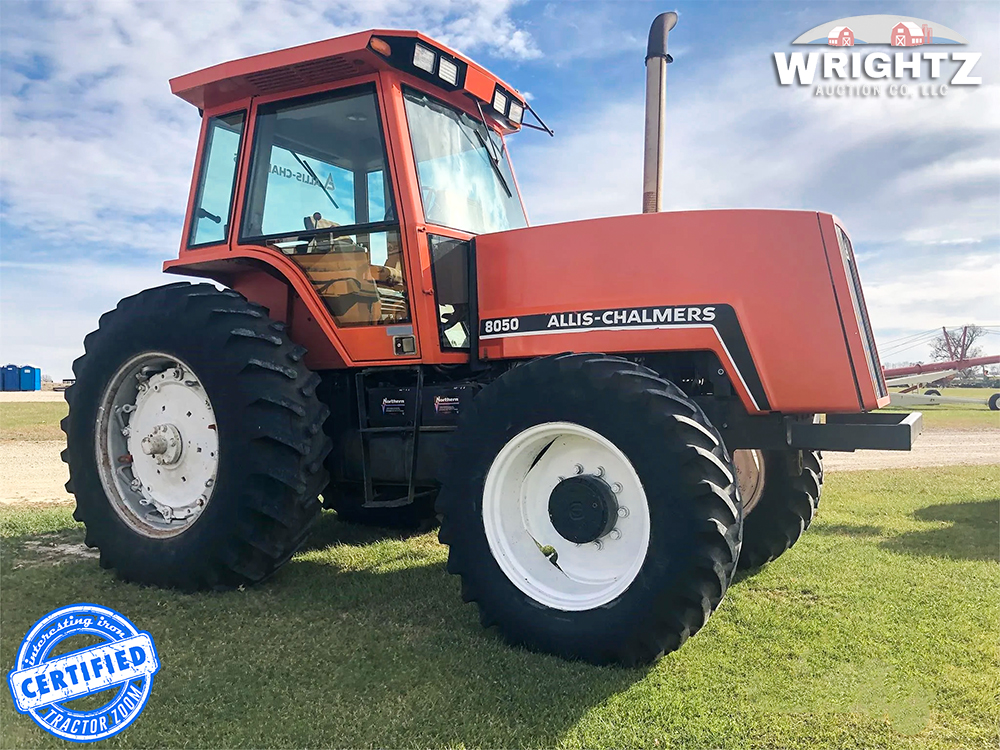
He also passed along Eugene’s number, so I gave him a call.
It turns out that Eugene is a 3rd-generation dairy farmer who’s in the process of slowing down a little. His sons Kurt & Kevin (and their families) have taken on most of the management duties of their 80-head milking operation and row-crop acres, but Eugene still sets his alarm to 3AM to help them with morning milking. “Once a dairyman, always a dairyman,” he said with a bit of a laugh.
The tractor:
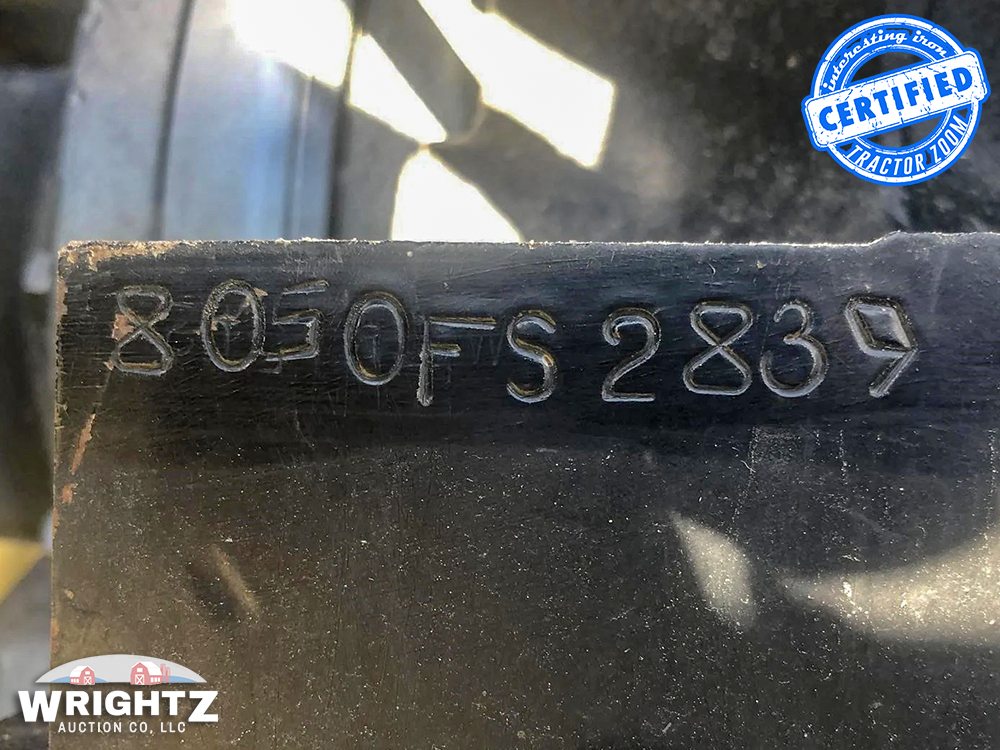
Eugene told me that he’s the second owner of this 12-speed Power Shift 8050. He bought it at a farm auction in Cuba City, WI in 1996 and I believe he told me that at the time, it had 3600 hours on it. Since then, it’s done lots of things at their farm – everything from snow removal to moldboard plowing. Most recently, it’s seen the most duty pulling a chopper for haylage. Honestly, the tractor has had a fairly easy life over the past few years.
It’s been very well-maintained, too. Eugene rattled off a list as long as your arm (including dates) of things that had been done to keep it in good shape. I tried to take notes but furious scribbling was of little use – I couldn’t keep up. However, here are the most recent important highlights, as far as I’m concerned: it’s got about 1000 hours on a new motor (2015), new batteries just over a year ago, new filters and new seals on the injection pump this past May, and a new cable for the park pawl in June. The rubber is fairly fresh as well (the duals are pretty well worn, but they’ll hold air), and he did tell me that he’d had it repainted a few years ago as well.
My take on it:
Honestly, this tractor has a lot going for it. It’s clean as a whistle, it’s in great mechanical shape, it’s got good rubber, and the interior is very clean as well. A cab kit wouldn’t hurt; I’m sure the foam could use replacement, and there’s a spot where the headliner is loose, but the seat isn’t super-chewed up like you often see when it comes to tractors of this era. The A/C has been converted to R134a already so you won’t have to mess with that, either. It’s also got a full rack of 14 weights.

At the end of the day, the stuff that needs attention on this 8050 is all pretty minor. Winter project-type/weekend type stuff. All it really needs is a farmer to put it to work!
What’s it worth?
When I talked with Scott, he’s hoping for $34,000 out of it like the last 8050 he sold for Eugene. I think that’s about right, too; while the tractor does have more hours on the frame, it’s only got a thousand hours on a new motor. Furthermore, while the interior isn’t quite as perfect as the one from late last year, it’s got a full rack of weights and duals included in the sale. The December tractor didn’t have either of those things.
Honestly, I wouldn’t be terribly surprised if it went a little higher than Scott’s number. As many of you are well aware, wild and crazy things have been known to happen at live auctions. If two bidders start to get after it a little and there’s an internet bidder involved, who knows where it’ll end up? It’ll be a fun one to watch! (And I might do just that if I can sneak out of the office for part of the day!)
Here’s the auction info one more time, with links out to the listing on Tractor Zoom!
Auction Date: August 1, 2022 – 9AM CDT (Online bidding is open right now.)
Auctioneer: Wrightz Auction Co. LLC
Format: Live Auction with online bidding – 9AM CDT start time
Location: Floyd, IA
Auction Catalog
Link to the 1984 Allis-Chalmers 8050
Incidentally, Dairy Star wrote a nice article about the Leerhoff family not too long ago. Check it out here!
Related Interesting Iron Posts:
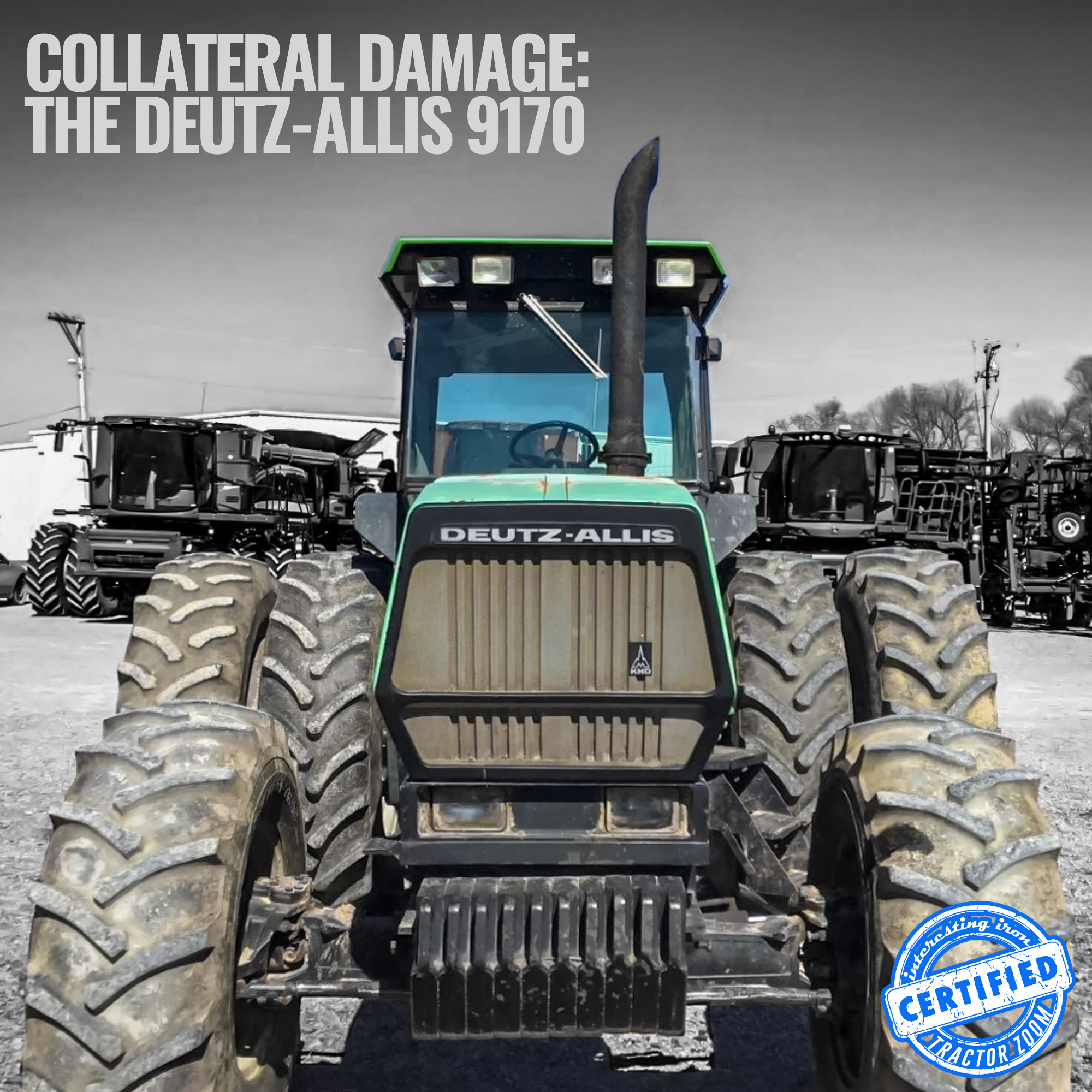
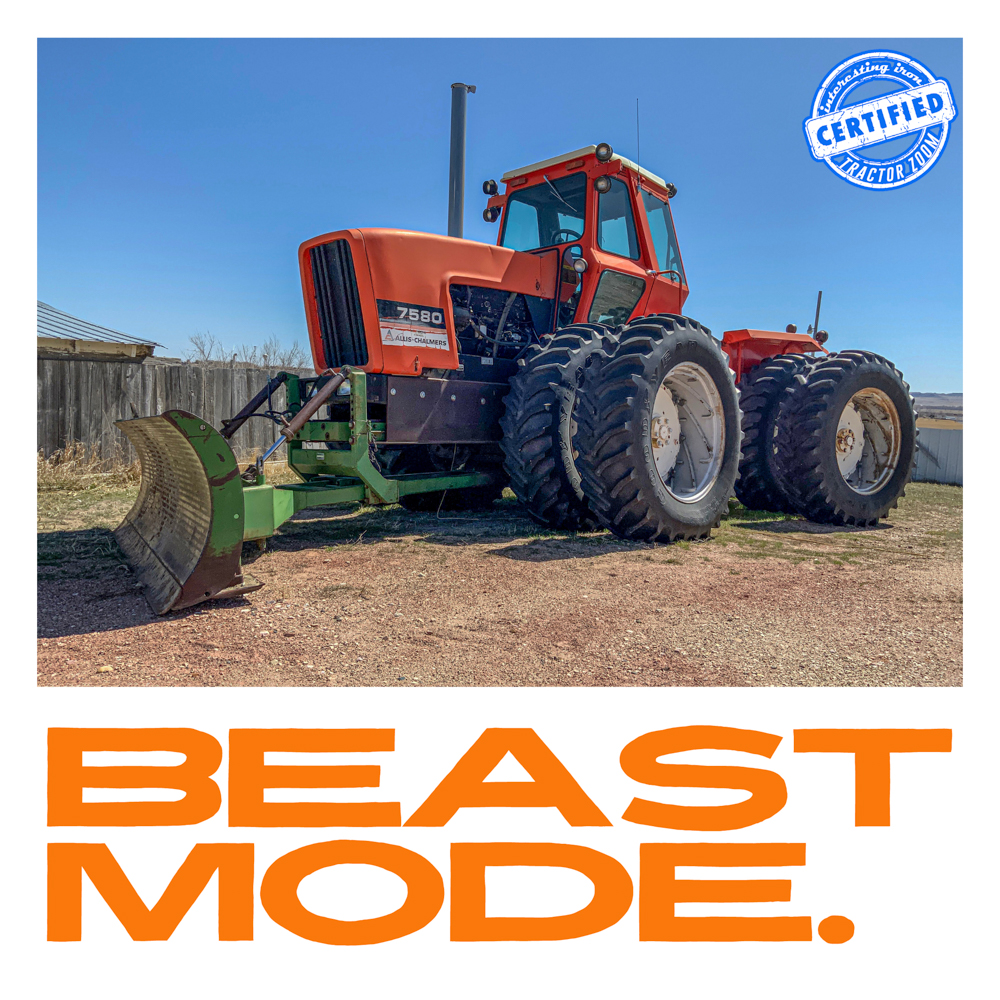
Recent Posts
See AllTractor Zoom is connecting farm equipment sellers and buyers faster than ever before. Finding farm equipment at auction or at a dealership has never been so easy.